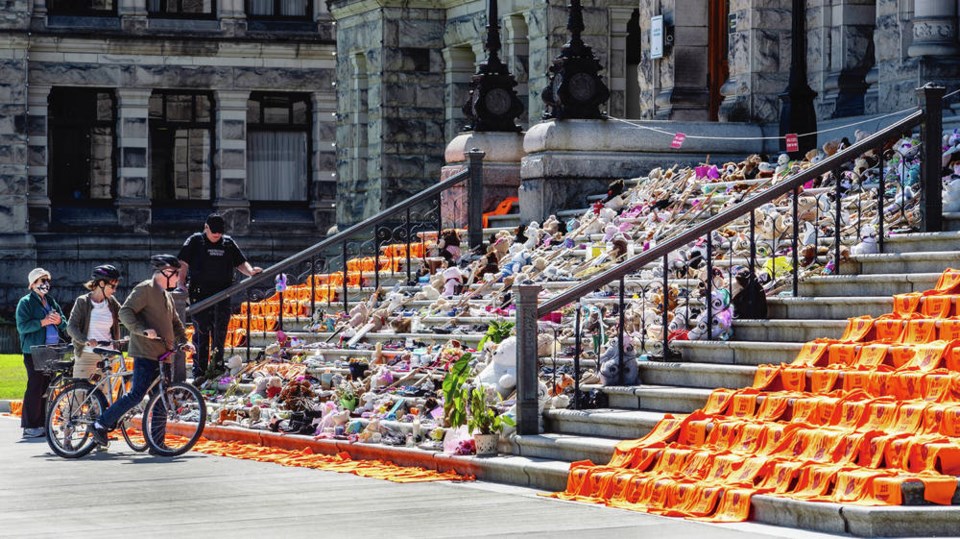The unspeakable discovery of children’s bodies beside a residential school funded by the federal government and administered by a religious organization brought Christopher Hitchens to mind.
Hitchens was an English-American social critic who wrote more than 30 books, but whose bestseller God is Not Great described in detail how most of the worst crimes against humanity throughout history had been (and still are) committed in the name of one organized religion or another.
Hitchens described himself as both an atheist and an “anti-theist” who saw organized religions as false, harmful and authoritarian. During his lifetime (he died in 2011), Hitchens spoke and was well received at both Christian and non-Christian organizations.
Full disclosure: I bought my copy of the book from the bookstore at Brigham Young University, a Mormon school where the book was on full display.
“The idea of a utopian state on Earth,” wrote Hitchens, “perhaps modelled on some heavenly ideal, is very hard to efface and has led people to commit terrible crimes in the name of the ideal.”
The Kamloops Indian Residential School was no exception. Established in 1893, it was finally closed as a day school in 1978.
During the school’s operation through the early decades of the 20th century, thousands of Secwepemc children between four and 15 were forcibly taken from their families and prohibited from practising their language, culture and traditions. Many faced abuse.
As might be expected when the truth stares those involved in the face, apologies have been tumbling into the daily media from anybody and everybody associated with the Kamloops school or any of the other 19 residential schools in sa���ʴ�ý, or the 180 or so schools across sa���ʴ�ý.
The schools were funded by the federal government but were administered by a variety of religious organizations, with about 47 per cent run by the Roman Catholic Missionary Oblates of Mary Immaculate, including the one in Kamloops from 1890 until 1969, when the federal government assumed control.
The system, sa���ʴ�ý-wide, had its origins in laws enacted before Confederation, but it was an amendment in 1894 to the Indian Act that made attendance at day schools, industrial schools or residential schools compulsory for First Nations children.
Why?
Perhaps the 1991 apology issued by the Oblates echoes Hitchens and offers the clearest explanation: “We apologize for the part we played in the cultural, ethnic, linguistic and religious imperialism that was part of the mentality with which the peoples of Europe first met the aboriginal peoples and which consistently has lurked behind the way the native peoples of sa���ʴ�ý have been treated by civil governments and by the churches … we were, naively, part of this mentality [which] from the beginning, and ever since, has continually threatened the cultural, linguistic, and religious traditions of the Native peoples.”
Although it took the recent discovery of 215 children’s bodies to bring the true horrors of the residential schools to front pages across sa���ʴ�ý, the Truth and Reconciliation Commission’s report in 2015 detailed deaths of more than 3,000 children in residential schools across sa���ʴ�ý.
Whether or not the Kamloops discovery will be a turning point in the Truth and Reconciliation Commission’s process remains to be seen. Interestingly, the Commission itself emerged from the Indian Residential Schools Settlement Agreement of 2007, the largest class-action settlement in Canadian history.
But apologies and expressions of regret don’t cut it for Mary Ellen Turpel-Lafond, a lawyer and former judge who is of Cree and Scottish descent and is now director of the Indian Residential School History and Dialogue Centre at the University of British Columbia.
Turpel-Lafond did not mince words, saying “the response from politicians and church officials that the discovery is ‘shocking’ rings hollow,” as Indigenous people have tried to raise awareness about the issue for years.
So where to go from here?
Reconciliation between non-Indigenous Canadians and the next generation of First Nations people will need to involve several elements, the first of which will be acceptance of the kind of brutal truth the Kamloops discoveries reveal. Beyond that, sa���ʴ�ý’s public education needs to move beyond just including Indigenous symbolism as part of its public image to a point where the requirements of Indigenous culture are integrated into the day-to-day organization of what are still Eurocentric assumptions about how to organize public schools.
Where to begin with that will be the topic of next week’s column.
Geoff Johnson is a former superintendent of schools.



